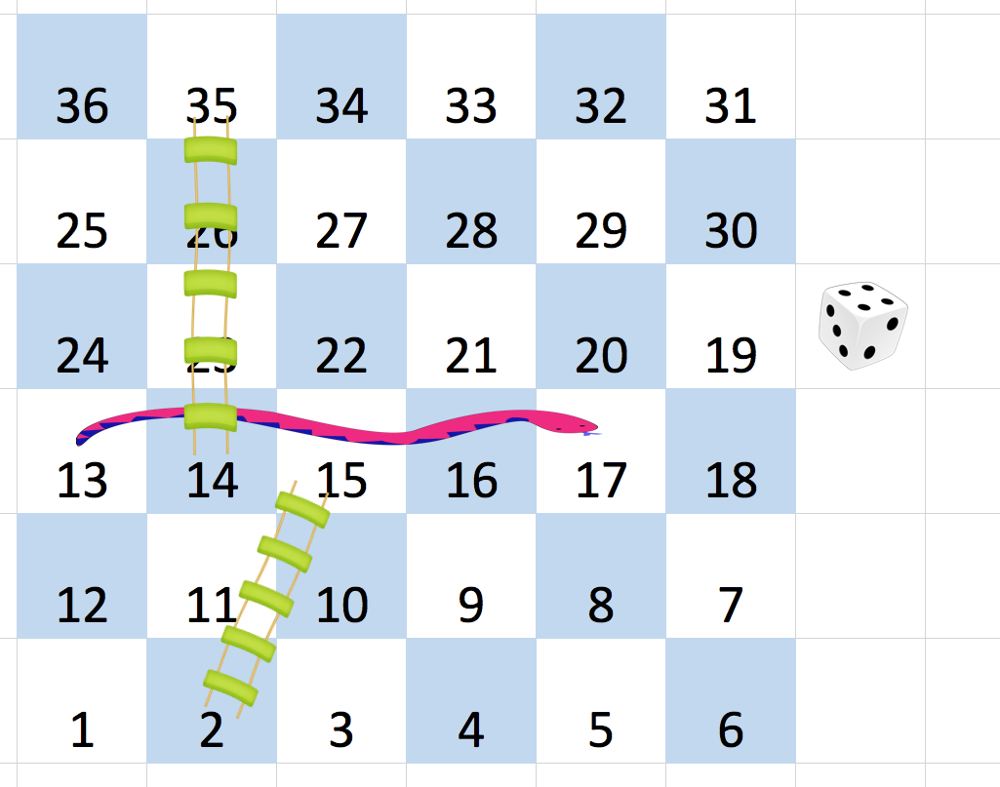909. Snakes and Ladders
Description
You are given an n x n integer matrix board where the cells are labeled from 1 to n2 in a Boustrophedon style starting from the bottom left of the board (i.e. board[n - 1][0]) and alternating direction each row.
You start on square 1 of the board. In each move, starting from square curr, do the following:
- Choose a destination square
nextwith a label in the range[curr + 1, min(curr + 6, n2)].- This choice simulates the result of a standard 6-sided die roll: i.e., there are always at most 6 destinations, regardless of the size of the board.
- If
nexthas a snake or ladder, you must move to the destination of that snake or ladder. Otherwise, you move tonext. - The game ends when you reach the square
n2.
A board square on row r and column c has a snake or ladder if board[r][c] != -1. The destination of that snake or ladder is board[r][c]. Squares 1 and n2 are not the starting points of any snake or ladder.
Note that you only take a snake or ladder at most once per dice roll. If the destination to a snake or ladder is the start of another snake or ladder, you do not follow the subsequent snake or ladder.
- For example, suppose the board is
[[-1,4],[-1,3]], and on the first move, your destination square is2. You follow the ladder to square3, but do not follow the subsequent ladder to4.
Return the least number of dice rolls required to reach the square n2. If it is not possible to reach the square, return -1.
Example 1:
Input: board = [[-1,-1,-1,-1,-1,-1],[-1,-1,-1,-1,-1,-1],[-1,-1,-1,-1,-1,-1],[-1,35,-1,-1,13,-1],[-1,-1,-1,-1,-1,-1],[-1,15,-1,-1,-1,-1]] Output: 4 Explanation: In the beginning, you start at square 1 (at row 5, column 0). You decide to move to square 2 and must take the ladder to square 15. You then decide to move to square 17 and must take the snake to square 13. You then decide to move to square 14 and must take the ladder to square 35. You then decide to move to square 36, ending the game. This is the lowest possible number of moves to reach the last square, so return 4.
Example 2:
Input: board = [[-1,-1],[-1,3]] Output: 1
Constraints:
n == board.length == board[i].length2 <= n <= 20board[i][j]is either-1or in the range[1, n2].- The squares labeled
1andn2are not the starting points of any snake or ladder.
Solutions
Solution 1: BFS
We can use the Breadth-First Search (BFS) method, starting from the starting point, moving forward 1 to 6 steps each time, and then checking for snakes or ladders. If there are any, move to the destination of the snake or ladder; otherwise, move to the next square.
Specifically, we use a queue \(\textit{q}\) to store the current reachable square numbers, initially putting number \(1\) into the queue. At the same time, we use a set \(\textit{vis}\) to record the squares that have been reached to avoid revisiting them, initially adding number \(1\) to the set \(\textit{vis}\).
In each operation, we take out the square number \(x\) at the front of the queue. If \(x\) is the endpoint, we can return the current number of steps. Otherwise, we move \(x\) forward 1 to 6 steps, setting the new number as \(y\). If \(y\) falls outside the board, we skip it directly. Otherwise, we need to find the row and column corresponding to \(y\). Since the row numbers decrease from bottom to top, and the column numbers depend on the parity of the row, we need to perform some calculations to get the row and column corresponding to \(y\).
If the square corresponding to \(y\) has a snake or ladder, we need to move to the destination of the snake or ladder, denoted as \(z\). If \(z\) has not been visited, we add \(z\) to the queue and set, allowing us to continue the breadth-first search.
If we ultimately cannot reach the endpoint, we return \(-1\).
The time complexity is \(O(n^2)\), and the space complexity is \(O(n^2)\). Here, \(n\) is the length of the side of the board.
1 2 3 4 5 6 7 8 9 10 11 12 13 14 15 16 17 18 19 20 21 22 23 | |
1 2 3 4 5 6 7 8 9 10 11 12 13 14 15 16 17 18 19 20 21 22 23 24 25 26 27 28 29 30 31 | |
1 2 3 4 5 6 7 8 9 10 11 12 13 14 15 16 17 18 19 20 21 22 23 24 25 26 27 28 29 30 31 32 33 | |
1 2 3 4 5 6 7 8 9 10 11 12 13 14 15 16 17 18 19 20 21 22 23 24 25 26 27 28 29 30 31 32 33 | |
1 2 3 4 5 6 7 8 9 10 11 12 13 14 15 16 17 18 19 20 21 22 23 24 25 26 27 28 29 30 31 32 33 34 | |

